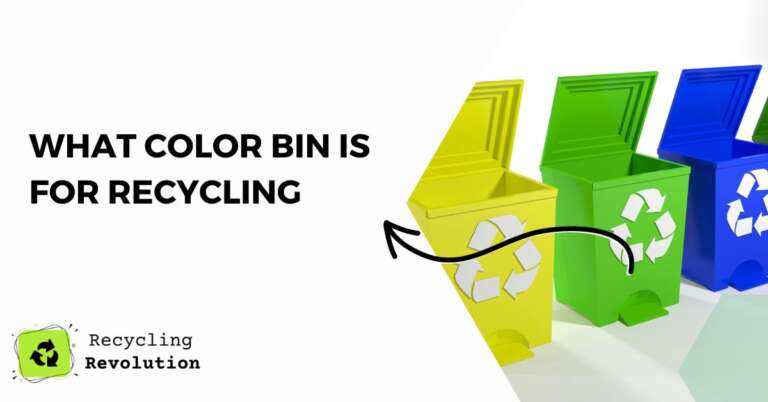We all want to do our part for the environment. Recycling is an excellent start, but it can get a bit tricky when it comes to figuring out what goes where. If you’ve ever asked yourself, “What color bin is for recycling?”, then you’re in the right place! Let’s unravel the color-coded mystery together.
TL;DR: The color coding for recycling bins varies widely based on your location and local recycling policies. Generally, green or blue bins are often used for recycling, but some areas may use different colors for different types of materials. Always check your local guidelines to ensure you’re recycling correctly.
Understanding Bin Color Codes
Recycling bin colors are not universal and can vary from place to place, but there are some common trends. For instance, blue and green bins are widely used for recyclable materials across many locations. But here’s where it gets more detailed:
| Color | Waste Type | Description and Examples |
|---|---|---|
| Blue | Paper/Cardboard | Newspapers, magazines, boxes, cardboard packaging |
| Green | Glass | Bottles, jars, any glass items |
| Brown | Organic/Biodegradable | Food waste, leaves, plant-based materials |
| Grey | General Waste | Non-recyclable waste, mixed waste |
| Yellow | Plastic | Bottles, containers, plastic packaging |
| Red | Hazardous | Batteries, electronic waste, chemicals |
| White | Medical or Special Waste | Needles, medical equipment, specific lab waste |
Please note that this is a broad generalization and it might not apply to your specific area.
Consult Your Local Guidelines
Because of this variability, I recommend always checking your local guidelines. These can usually be found on your city or county’s waste management website or through a quick call to your local waste management facility.
Understanding these color codes can make a significant impact on the efficiency of recycling programs, helping to reduce contamination and ensure that recyclable materials end up in the right place.
Creating a Home Recycling System
Once you understand your local recycling colors, you can create a home recycling system to make sorting easier.
- Label your bins: Clearly label each bin to prevent any confusion. You can even create a simple chart that lists what items go in each colored bin.
- Educate the family: Ensure all household members understand the recycling system. Consider turning it into a learning opportunity for children.
- Position bins strategically: Place your recycling bins next to your general waste bin to make it just as easy to recycle.
Note: Rinse out recyclables before tossing them in the bin to prevent contamination.
Understanding the Importance of Recycling
Before we dig deeper into the nitty-gritty of recycling bin colors, it’s crucial to understand the significance of recycling itself. Recycling is more than a weekly chore or a vague action to “save the environment.”
It’s an essential process that conserves natural resources, reduces pollution, and promotes a healthier, more sustainable future for us all.
When we recycle materials like plastic, paper, metal, and glass, we reduce the need for extracting, refining, and processing raw materials, all of which create air and water pollution. By reusing these materials, we can make a tangible difference in the world around us.
Different Types of Recyclable Materials
Recyclables aren’t a monolith; there are various types of recyclable materials, each with their own requirements for processing:
- Paper and Cardboard: Newspapers, magazines, mail, cardboard boxes, and other paper products can often be recycled in most curbside programs.
- Plastics: Not all plastics are created equal. Look for the recycling symbol with a number inside it on the bottom of plastic items. This number indicates the type of plastic, and not all types are recyclable in all areas.
- Metal: Aluminum cans, tin cans, and sometimes other types of metal can be recycled.
- Glass: Glass bottles and jars are commonly recyclable. However, other types of glass, like windows, ovenware, and eyeglasses, have different melting points and should not be mixed with glass bottles and jars for recycling.
Color Coding: A Global Perspective
While the above color coding system is commonly followed, it’s important to note that different countries may follow different color coding systems:
- United States: Blue bins are usually for recyclables, green for compost, and black for trash.
- United Kingdom: Black or green bins are usually for non-recyclable waste, blue for dry recyclables, brown for garden waste, and food waste bins can be any color but are often green or brown.
- Australia: Yellow bins are for recycling, green or red for general waste, and green or brown for garden waste.
Again, I want to stress the importance of checking your local guidelines to understand the specific recycling procedures in your area.
How to Improve Your Recycling Habits
Once you’ve mastered the color coding of recycling bins, consider these tips to level up your recycling habits:
- Reduce and Reuse: Before you recycle, consider if you can reduce your waste or reuse the item. Remember, recycling is just one part of the waste management hierarchy of Reduce, Reuse, Recycle.
- Avoid Wishcycling: Wishcycling is when you’re not sure if an item is recyclable, so you put it in the recycling bin in the hopes that it can be recycled. This well-intentioned habit can unfortunately cause contamination and more harm than good.
- Clean Your Recyclables: Rinse out containers, jars, and bottles before recycling. Food remnants can contaminate an entire load of recycling.
- Break Down Boxes: Flatten cardboard boxes before recycling to save space.
Remember, every small step toward better recycling habits counts in our collective effort to take care of our planet.
Alternative Recycling Options
If you find that your local recycling program doesn’t accept certain items (like batteries, electronics, or certain types of plastic), don’t despair! There are often specialty recycling programs that will take these items. Look for drop-off locations at local retailers or special collection events in your community.
Conclusion
Recycling is an imperative step towards safeguarding our environment and ensuring a sustainable future. While the maze of color-coded bins can initially appear perplexing, understanding and adhering to your local guidelines is pivotal in making a real difference. Recycling goes beyond mere disposal – it’s a conscientious effort to reduce, reuse, and recycle.
Being mindful of the type and condition of items we put in our bins can greatly enhance the efficiency of recycling programs. As global citizens, our collective endeavor in adopting appropriate recycling habits, no matter how minute, contributes monumentally to the wellbeing of our planet.
So, the next time you stand befuddled with an item in hand, remember the significance of your choice, consult your local guidelines, and make a decision that benefits not just you, but the world at large.
FAQs
Can I use any color bin for recycling if I label it?
While you can label your bins at home, using the correct color bins for curbside collection is essential. This helps waste management workers quickly identify which bins to empty into their recycling trucks.
What happens if I use the wrong bin color?
Mixing up bin colors can lead to recyclable materials being sent to landfill sites or general waste being contaminated with recyclables. Always try to use the correct bin to help your local recycling program run smoothly.
Can I recycle materials in plastic bags?
In most cases, you should avoid putting your recyclables in plastic bags, unless your local guidelines specifically allow it. Many recycling facilities can’t process plastic bags and doing so can contaminate the recycling stream.

